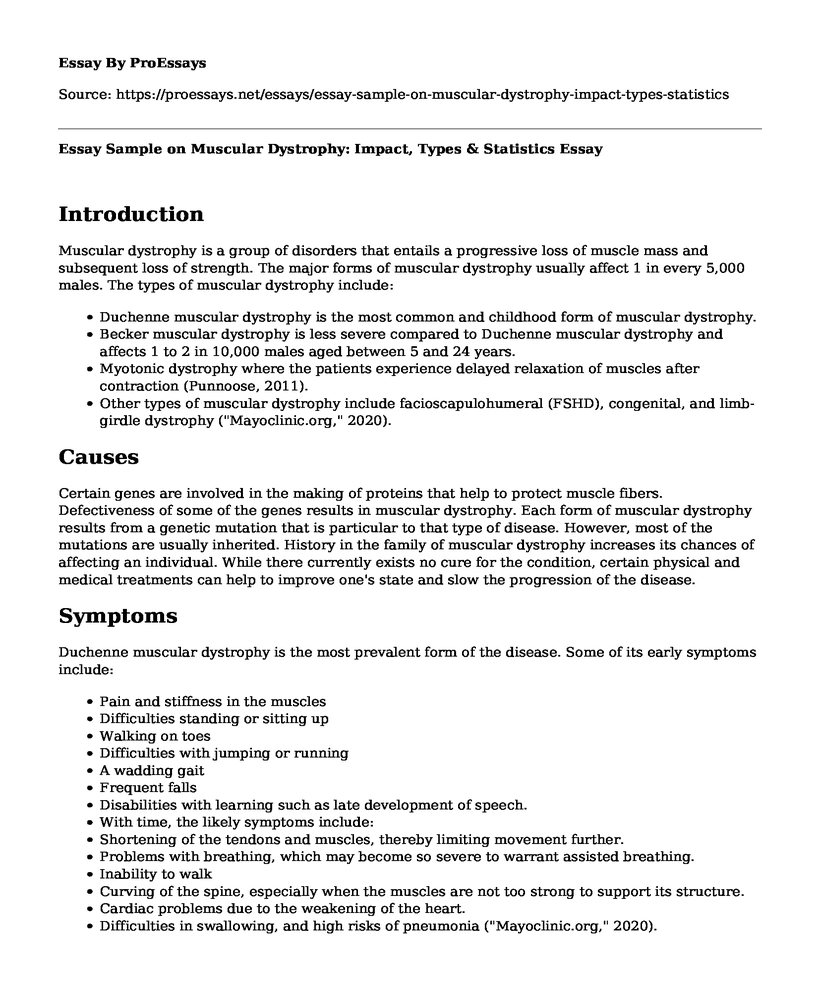Introduction
Muscular dystrophy is a group of disorders that entails a progressive loss of muscle mass and subsequent loss of strength. The major forms of muscular dystrophy usually affect 1 in every 5,000 males. The types of muscular dystrophy include:
- Duchenne muscular dystrophy is the most common and childhood form of muscular dystrophy.
- Becker muscular dystrophy is less severe compared to Duchenne muscular dystrophy and affects 1 to 2 in 10,000 males aged between 5 and 24 years.
- Myotonic dystrophy where the patients experience delayed relaxation of muscles after contraction (Punnoose, 2011).
- Other types of muscular dystrophy include facioscapulohumeral (FSHD), congenital, and limb-girdle dystrophy ("Mayoclinic.org," 2020).
Causes
Certain genes are involved in the making of proteins that help to protect muscle fibers. Defectiveness of some of the genes results in muscular dystrophy. Each form of muscular dystrophy results from a genetic mutation that is particular to that type of disease. However, most of the mutations are usually inherited. History in the family of muscular dystrophy increases its chances of affecting an individual. While there currently exists no cure for the condition, certain physical and medical treatments can help to improve one's state and slow the progression of the disease.
Symptoms
Duchenne muscular dystrophy is the most prevalent form of the disease. Some of its early symptoms include:
- Pain and stiffness in the muscles
- Difficulties standing or sitting up
- Walking on toes
- Difficulties with jumping or running
- A wadding gait
- Frequent falls
- Disabilities with learning such as late development of speech.
- With time, the likely symptoms include:
- Shortening of the tendons and muscles, thereby limiting movement further.
- Problems with breathing, which may become so severe to warrant assisted breathing.
- Inability to walk
- Curving of the spine, especially when the muscles are not too strong to support its structure.
- Cardiac problems due to the weakening of the heart.
- Difficulties in swallowing, and high risks of pneumonia ("Mayoclinic.org," 2020).
Treatment
There exists no cure at the moment for muscular dystrophy. The treatment options at the moment entail the use of medications and various therapies to slow the progression of the disorder and enhance patient mobility for the longest time possible.
Drugs
The most common drugs prescribed for muscular dystrophy include:
- Heart medications which are used when the disease has an impact on the heart. In this case, angiotensin-converting enzyme (ACE) inhibitors and beta-blockers may greatly help.
- Corticosteroids which is a type of medication that helps to enhance muscle strength and slow progression of muscular dystrophy ("Medical News Today," 2020).
Physical Therapy
These include:
- General exercises to help combat the inevitable inward movement of the limbs when the muscles and tendons shorten.
- Breathing assistance involves the use of devices to improve the delivery of oxygen to the muscles through the night.
- Use of mobility aids such as canes, walkers, and wheelchairs.
- Use of braces to keep the muscles and tendons stretched and slow their shortening.
Diagnosis
Among the techniques used to diagnose muscular dystrophy include:
- Genetic testing where changes in genetic mutations can be screened as they occur in muscular dystrophy.
- Enzyme assay which involves analysis of creatine kinase (CK) to suggest the development of muscular dystrophy.
- Electromyography to measure the electrical activity and indicate signs of muscle disease.
- Heart monitoring through echocardiograms and electrocardiography to detect any adjustments in the musculature of the heart ("Medical News Today," 2020).
- Biopsy to remove any portion of a muscle and examining it to highlight any signs of muscular dystrophy.
References
"MayoClinic," (2020). Muscular dystrophy. Mayoclinic.org. https://www.mayoclinic.org/diseases-conditions/muscular-dystrophy/symptoms-causes/syc-20375388#:~:text=Muscular%20dystrophy%20is%20a%20group,many%20kinds%20of%20muscular%20dystrophy.
"Medical News Today," (2020). All about muscular dystrophy. Medicalnewstoday.com. https://www.medicalnewstoday.com/articles/187618
Punnoose AR, (2011). Muscular Dystrophy. JAMA. 306(22):2526. DOI:10.1001/jama.2011.1794
Cite this page
Essay Sample on Muscular Dystrophy: Impact, Types & Statistics. (2023, Apr 23). Retrieved from https://proessays.net/essays/essay-sample-on-muscular-dystrophy-impact-types-statistics
If you are the original author of this essay and no longer wish to have it published on the ProEssays website, please click below to request its removal:
- Article Review Sample - Placebo Use in the UK
- Legal Nurse Consultant Profession Paper Example
- Essay Sample on Discovering Haiti: A Multicultural Nursing Course Exploration
- Singapore's Primary Care System: 6 Regional Groups Anchored By Hospitals - Essay Sample
- Globalization Impact on Nurses: Critical Thinking & More - Essay Sample
- Nurses' Perspectives on Bed Enclosure - Free Article Review
- Teaching Children with Disabilities - Free Paper Sample







